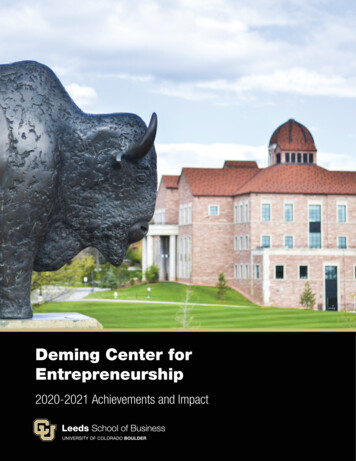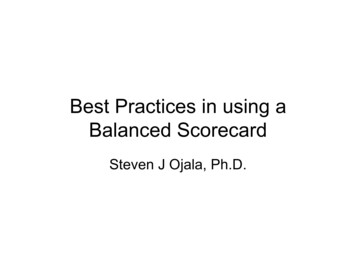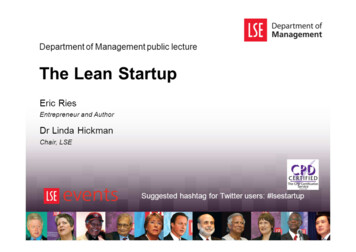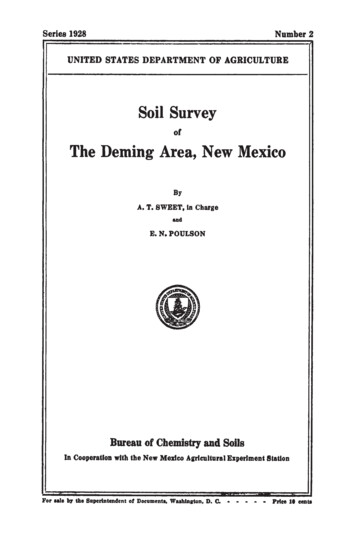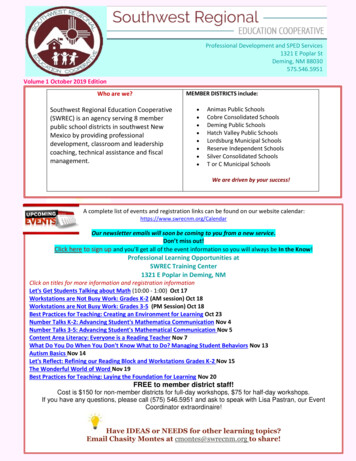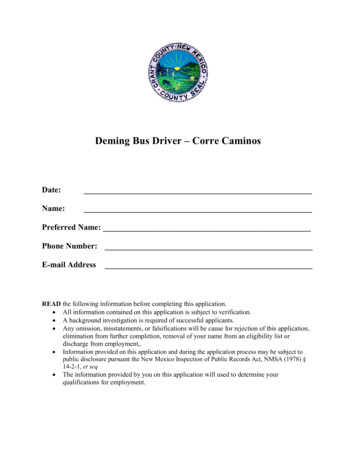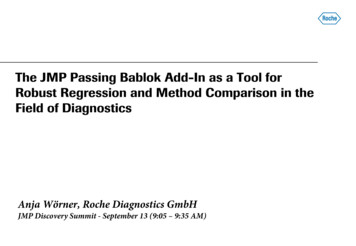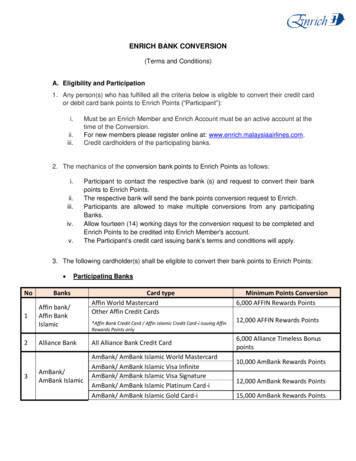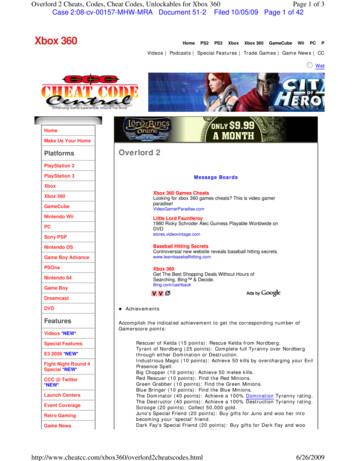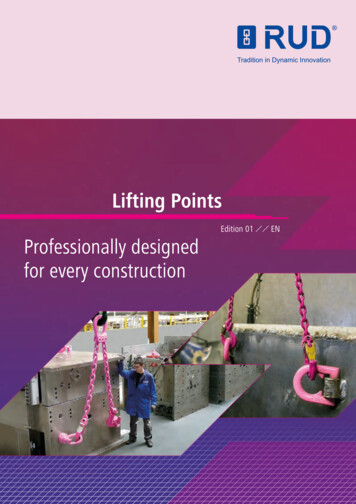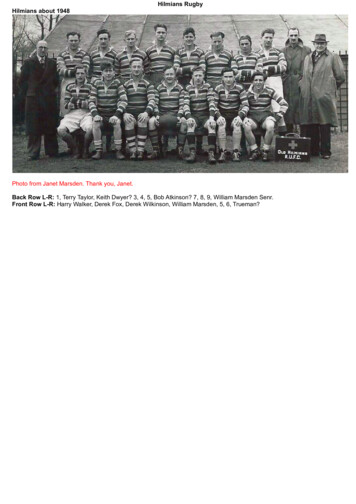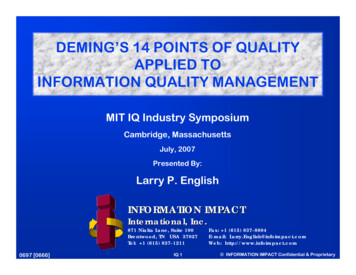
Transcription
DEMING’S 14 POINTS OF QUALITYAPPLIED TOINFORMATION QUALITY MANAGEMENTMIT IQ Industry SymposiumCambridge, MassachusettsJuly, 2007Presented By:Larry P. EnglishINFORMATION IMPACTInternational, Inc.871 Nialta Lane, Suite 100Brentwood, TN USA 37027Tel: 1 (615) 837-12110697 [0666]IQ 1Fax: 1 (615) 837-8804E-mail: Larry.English@infoimpact.comWeb: http://www.infoimpact.com INFORMATION IMPACT Confidential & Proprietary
COPYRIGHT 1987- 2007INFORMATION IMPACT International, Inc., Confidential & Proprietary871 Nialta Lane, Ste 100Brentwood, TN 37027Tel: 1-615-837-1211Fax: 1-615-837-8804Email: info@infoimpact.comWeb Site: http://www.infoimpact.comThis material is the sole property of INFORMATION IMPACT International, Inc., World rightsreserved. This document Is based on trade secrets or copyrighted material owned byInformation Impact International, Inc. No part of this document may be stored in a retrievalsystem, transmitted or reproduced in any way, including but not limited to photocopy,photograph, magnetic or other record, without the prior agreement and written permission ofINFORMATION IMPACT International, Inc.TIQM and TQdM are registered trademarks of INFORMATION IMPACTInternational, Inc.Is a registered trademark of INFORMATION IMPACT International, Inc.IQMMTM is a trademark of INFORMATION IMPACT International, Inc.RADDTM is a trademark of INFORMATION IMPACT International, Inc.0603 [0602]IQ 2 INFORMATION IMPACT Confidential & Proprietary
Larry P. EnglishPresident and PrincipalMr. English is an internationally recognized speaker, educator, author and consultant ininformation and knowledge management and information quality improvement. He alsoprovides consulting and education in information stewardship, strategic informationvisioning, information technology evaluation, information resource management and dataadministration, data modeling and facilitation, and value-centric application developmentmethods.Mr. English has developed the Total Quality data Management (TIQM )methodology applying Kaizen quality principles to information quality management. Hechairs Information Quality Conferences around the world and he is a co-founder of theInternational Association of Information and Data Quality (IAIDQ).Prior to founding INFORMATION IMPACT International, Inc. (www.infoimpact.com), Brentwood, TN, over nineteenyears ago, Mr. English was Vice President of an international IRM consulting firm. Before that, he was manager ofsystems development and then for information management with a large publishing firm. Before positions as SeniorInstructor for a computer manufacturer and Information Systems Training Coordinator for a major insurance firm, Mr.English began his career with Sears, Roebuck, and Co., as a programmer and systems analyst.He was featured as one of the “21 Voices for the 21st Century” in the January, 2000 issue of Quality Progress.DAMA awarded him the 1998 “Individual Achievement Award” for his contributions to the field of information resourcemanagement. Mr. English has served as an Adjunct Associate Professor in computer science. He is a member of theAmerican Society for Quality and is a former advisor for DAMA. He has also been an active member of various ANSI(American National Standards Institute) standards committees, and he is an editorial advisor for DM Review.A magna cum laude graduate of Hardin-Simmons University, Mr. English holds a Masters Degree from the SouthernBaptist Theological Seminary where he was a Luther Rice Scholar and a Garrett Fellow. He is listed in OutstandingYoung Men in America and Who’s Who Worldwide. He has provided consulting and educational services in more than30 countries on five continents to such organizations as Aera Energy, Air Canada, American Express, Belgacom,Boeing, British Telecom, Coca-Cola Foods, Dow Chemical, Eastman Kodak, Eli Lilly, the FDIC, Hewlett-Packard, TheHartford, IBM, L. L. Bean, NTT DATA, Optical Fibres, Sprint, Telenor, Toyota Motor Sales, UNUM Life Insurance Co.,the U.S. Navy, Western Health Alliance and Weyerhaeuser.A frequent keynote speaker, Mr. English writes the monthly “Plain English about Information Quality” column forDM Review, and is the author of the highly acclaimed Improving Data Warehouse and Business Information Quality,also available in Japanese, and numerous articles for publications in the US and Europe.0604IQ 3 INFORMATION IMPACT Confidential & Proprietary
DEMING’S MANAGEMENT THEORYIN THE INFORMATION AGELearning ObjectivesR Understand How Dr. Deming’s Theoryof Management applies to Managementin the Information AgeR Understand How Deming’s 14 Points ofTransformation Apply to InformationQuality Management05245 [05244]IQ 4 INFORMATION IMPACT Confidential & Proprietary
P6W. EDWARDS DEMING’SSYSTEM OF PROFOUND KNOWLEDGE*R Appreciation of theOrganization as a SystemR Knowledge about VariationR Theory of KnowledgeR Understanding of Psychology*W. Edwards Deming, The New Economics, pp. 92ff.5403IQ 5 INFORMATION IMPACT Confidential & Proprietary
SUB-OPTIMIZED VALUE / COST CHAINSvc Date:Equip Type:Problem Desc:Ord Date: 3/12/00Cust ID: 44123Tel Num: 555-1234Time:3 hours(2-6 hours)Rediscover}Value Chain: “An end-to-end set ofactivities that begins with a requestfrom a customer and ends with a . benefit to a customer.”“FunctionalOptimization” DysfunctionalEnterprisePC artap iatu lreRepair I/TI/T I/T VC: Value Basis4792GN[4793GN, 4737T, 8520-25]NVC: Non-Value Adding Cost WasteIQ 6 INFORMATION IMPACT Confidential & Proprietary
Repair OrderFactsSvc Date: 3/15/00Equip Type:M12AB01Problem Desc:Poor volume outOPTIMIZED VALUE CHAINIQ Point 9: “Break downbarriers betweenbusiness areas.”2-6 hoursRediscover“Value chain”(Enterprise)Optimization Effective LearningOrganizationOrd Date: 3/12/00Cust ID: 44123Tel Num: 555-1234Time:3.2 stBenefitShared DataControlled Distribution VC: Value Basis4793GN [4792GN, 4189G, 4737T, 8526-30, 8544-45] NVC: Non-Value Adding Cost WasteIQ 7 INFORMATION IMPACT Confidential & Proprietary
CustomerFocusO Customer satisfactionO Supplier / Customer PartnershipR Process ImprovementO Process definitionO Product specification (customer-focused)O Process Improvement (CPI) andReengineering (BPR)R Proven, scientific MethodsO Statistical quality controlO PDS/CA (Shewhart) cycleR Management Accountability0870 [0807, 0896, 8818]IQ 8UpdateDefectsCPIBPRCPI4030Upper Control Limit2010Lower ControlLimitOrgCustomerRTHE FUNDAMENTAL QUALITY OSTUDYTimeCPI Continuous Process ImprovementBPR Business Process Reengineering INFORMATION IMPACT Confidential & Proprietary
P6TOTAL QUALITY MANAGEMENTDeming’s 14 Points1. Create constancy of purpose for improvement ofproduct and service2. Adopt the new philosophy. In a new economic age3. Cease dependence on mass inspection to achievequality . . . but from improving the production process4. End the practice of awarding business on the basis ofprice tag alone. Instead, minimize total cost5. Improve constantly and forever the system of production and service to improve quality and decrease cost6. Institute training7. Adopt and institute leadership with the aim to helppeople and machines do a better jobSource: Deming, Out of the CrisisLarry English, Improving Data Warehouse and Business Information Quality, p3380812 [0819, 0820, 4092-98]IQ 9 INFORMATION IMPACT Confidential & Proprietary
P6TOTAL QUALITY MANAGEMENTDeming’s 14 Points (Cont.)8. Drive out fear, so everyone may work effectively9. Break down barriers between staff areas10. Eliminate slogans, exhortations and targets for thework force11. Eliminate numerical quotas for the work force andnumerical goals for people in management12. Remove barriers that rob people of pride ofworkmanship13. Institute a vigorous program of education and selfimprovement for everyone14. Take action to accomplish the transformation. Puteveryone to work to accomplish the transformationSource: Deming, Out of the CrisisLarry English, Improving Data Warehouse and Business Information Quality, p3380813 [0819, 0820, 4092-98]IQ 10 INFORMATION IMPACT Confidential & Proprietary
P6IQ 1. CREATE CONSTANCY OF PURPOSE FORIMPROVEMENT OF INFORMATION PRODUCT & SERVICEPt 1R Management’s two sets of problems:OOThose of today: “It is easy to stay bound up in the tangled knots of theproblems of today, becoming even more efficient in them.”Those of tomorrow: “No company without a plan for the future will stayin business.”DemingR “The obligation to the customer never ceases”º Information Quality ramifications:OOODefine IM / IQ Mission, Vision and Objectives based onenterprise mission and vision to include quality for informationproducts & services to meet information consumers’ needsDevelop IM / IQ plans with both long term and short termdeliverables that enable strategic business objectivesImplement and define IM / IQ processes & tools with customerfocus that leads to quality & process improvementR “The obligation to the knowledge worker never ceases”IM Information ManagementSource: L. English, Improving Data Warehouse and Business Information Quality, p 339 0854 [4832-45, 4714-16]IQ 11 INFORMATION IMPACT Confidential & Proprietary
P6INFORMATION QUALITY“Consistentlymeeting*all knowledge workers’ and end-customers’expectations”through information and information services so: Knowledge workers accomplish enterprise objectives Customers are successfulLarry P. English, TIQM º Components of Data and Information Quality: Definition (and Architecture) Content Presentation*World-class organizations do not stop here—they strive to “delight” their customers3851IQ 12 INFORMATION IMPACT Confidential & Proprietary
P6IQ 2. ADOPT THE NEW PHILOSOPHY—Pt 2QUALITY INFORMATION REDUCES COSTSR The economic realities of today require new standards“Reliable service reduces costs”Deming“Point two really means . . . a transformation of management”Demingº Information Quality ramifications:O Enable a paradigm shift to information as a sharedbusiness resource and quality information as a productO Implement quality information philosophy and policy: “Reliable, managed information reduces costs andincreases value” “Reliable, quality shared information reduces costsand increases value”OThis means a transformation of business and informationsystems management Business management accountability for information Systems management accountability for value deliverySource: L. English, Improving Data Warehouse and Business Information Quality, p 342 0858 [4832-45, 4714-16]IQ 13 INFORMATION IMPACT Confidential & Proprietary
P5.2aTHE REAL CAUSES OF POOR QUALITY INFORMATIONR Precipitating causes:OOFailure to treat and manage information as a strategicenterprise resourceFailure to treat and manage information as a productof business, manufacturing and service processesR Root causes:OOOverlaying information technology on top of obsoleteindustrial organization & management structureBuilding information technology “solutions” using the“systems approach” instead of “systems thinking”² i.e., automating the Industrial-Age functions versustransforming the cross-functional value chain3986IQ 14 INFORMATION IMPACT Confidential & Proprietary
P3THE BUSINESS CASE FOR IQ MANAGEMENT:Poor Quality Information CostsR “As much as 40 to 50 % or more of the typical ITbudget is really ‘information scrap and rework’” andwaste of moving and transforming data to disparatelydefined redundant databases*R “Poor quality information often causes 40 to 60 % ofmanufacturing scrap and rework costs”º “The direct costs of poor quality information, includingirrecoverable costs, rework of products and services,workarounds, and fines and customer compensationcan be as high as 15 to 25 percent of a largeorganization’s [operating] revenue or budget.”**L. English, Improving Data Warehouse and Business Information Quality, p. 125215 [5229]IQ 15 INFORMATION IMPACT Confidential & Proprietary
P6IQ 3. CEASE DEPENDENCE ON DATA MODEL & DATAINSPECTIONS ALONE—DESIGN QUALITY INTO PROCESSPt 3R Quality assurance (inspection) has a goal to discover faultyproducts and correct them (rework) or throw them out (scrap)“Quality comes not from inspection but from improvement of the process”Demingº Information Quality ramifications:OOOReplace data model and definition “review and approval”with front-end; cross-functional, business-driven datamodeling that builds quality in and produces databasesthat are (1) stable, (2) flexible, and (3) reusedReengineer processes to eliminate causes of defectsbefore automating themDesign error-proofing techniques into the databases,process, forms, application screens and programs, andprocedures and training that prevent cause of defectsSource: L. English, Improving Data Warehouse and Business Information Quality, p 345 0859 [4832-45, 4714-16]IQ 16 INFORMATION IMPACT Confidential & Proprietary
P2.7QUALITY CONTROL: MANUFACTURING vs INFORMATIONObjectiveMANUFACTURING:Improvement actionon a production processProcess controlProcess analysisDesign of ment actionon a production processProcess controlProcess analysisDesign mpleDataSamplingImprovement ActionDataPopulationSampleCollect dataObject bject /EventImprovement ActionThe relation between products and samples, anddata population and data samples and object / event5267 [5266, 4043, 4044]SampleIQ 17Source: Ishikawa, Guide to Quality Control;See L. English, Improving Data Warehouseand Business Information Quality, pg. 184 INFORMATION IMPACT Confidential & Proprietary
P5TIQM METHODOLOGYPROCESS P5:Improve Information Process QualityStartP1.4, 5, 6P2.3, 8P3.6P4.6P5.1P5.2P5.3DefineProject forInformationQualityImprovementDevelop PlanforInformationQualityImprovementDo4ACTP5.5Act toStandardizeInformationQualityImprovementsL. English, ImprovingData Warehouse andBusiness InformationQuality, p. 290.0965ov [0899, 3368-69]1PLANShewhart3 4Study/CheckImpact ofInformationQualityImprovements ImplementedPlan-Do-Study/Check-Act (PDS/CA)IQ 18IQ ProcessImprovements INFORMATION IMPACT Confidential & Proprietary
P5.2aMgt environmentCAUSE-AND-EFFECT DIAGRAMOrder Entry ErrorsApplication /DatabaseTechnologyMachinesCustInformationomer Materials EffectNo emphasisHas privacySlow responseon trainingconcernstimeDB reloadedDoes not tell theySystemhave movedNoQuota with duplicatesName“down”Does not rememberaccounchangeMultipleprevious ordertabilityCustomer look-up Customer systemalgorithm faultyDuplicateCustomerrecordscreatedthat causes us toPostal file tocheck addr isout of dateDoes not ask ifcustomer has placedAlienate / loseorderbeforeCustomers;No step to ask allDoes not follow Waste moneyinformation toNo standardsRushes toInfo standardson mail,for name & addr determine duplicate meet quotaresources,ConflictingproceduresDoes not understandcustomer’s nameMeasurementOrderProcess /ProceduresMethods3819 [0881, 0884, 3888, 4998]Lack of knowledgeof customer look-upproceduresInformationProducerrecovery &correctionBusinessEffectWants to be “customerservice” oriented and doesnot ask for customer numberhuManIQ 19 INFORMATION IMPACT Confidential & Proprietary
P6IQ 4. END THE PRACTICE OF PROJECTS OR DATACAPTURE ON COST OR TIME MEASURES ALONEPt 4R The practice of lowest price has had the impact ofactually increasing costs while increasing defects—instead, minimize “total costs” of ownership“Price has no meaning without a measure of the quality purchased”Deming“Purchasing should be a team effort and . include . representatives .Demingof [all] departments involved with the product”“A buyer will serve his company best by developing a long-termDemingrelationship of loyalty and trust with a single vendor”º Information Quality ramifications:Include quality guarantee / measures in cost estimateO Measure software & information “cost of ownership"O Develop databases to support all knowledge workersO Develop relationships of trust in information producersOSource: L. English, Improving Data Warehouse and Business Information Quality, p 350 0861 [4832-45, 4714-16]IQ 20 INFORMATION IMPACT Confidential & Proprietary
P2.8UCLCUSTOMER INFORMATION ACCURACYControl Chart 2000-200340Measured 35Accuracy 30Mean25Short Term20TargetLCL15105Long Term0TargetQ3,0 Q4,0 Q1,1 Q2,1 Q3,1 Q4,1 Q1,2 Q2,2 Q3,2 Q4,2 Q1,3 Q2,3 Q3,3 Q4,3 Q1,4Inaccurate data0847 [9997OP, 9998-GV]MeanUpper Control LimitIQ 21Lower Control LimitAccuracy Temp Std INFORMATION IMPACT Confidential & Proprietary
P6APPLICATION DEVELOPMENT PARADIGMSR Wrong: Application Requirements Analysis (“IPO”*only)Pt eProcessInputOutputProcessProcess Right: *Value Chain Analysis Process* Identify information required by downstream knowledge workers inherent tocreate processes & information required from upstream information producers*SIPOC Supplier-Input-Process-Output-Customer1372 [1370, 1330]IQ 22 INFORMATION IMPACT Confidential & Proprietary
P6IQ 5. IMPROVE CONSTANTLY & FOREVER PROCESSESOF I/S DEVELOPMENT & INFORMATION “PRODUCTION”R Improvement is not a one time effort–management isobligated to continual improvementPt 5Quality “must be built in at the design stage”Deming“Everyone and every department in the company must subscribe to constantimprovement”Mary WaltonR Fixing a problem is not the same as process improvementº Information Quality ramifications:O Data cleansing is not same as process improvementO Identify and involve the customers of IRM products andservices—understand their information req’sO Design quality into process, application and databaseinvolving knowledge workers in the design (QFD**)O Everyone and every unit must participate in continualinformation process improvement*IRM Information Resource Management Information Systems** QFD Quality Function DeploymentSource: L. English, Improving Data Warehouse and Business Information Quality, p 358 INFORMATION IMPACT Confidential & ProprietaryIQ 230863 [4832-45, 4714-16] I/S
P6IQ 6. INSTITUTE TRAINING FORINFORMATION QUALITYR Proper training is essential for workers to perform theirjobs effectivelyPt 6“If someone learns how to play the piano from a self-taught piano teacher;they will learn a lot wrong, some right” and “neither pupil nor teacherwill know what is right and what is wrong”DemingR Information Quality ramifications:O Institute IQ education and training at all levels: Executive Leadership Business Management Knowledge Workers and Information Producers Information Systems Management Information Resource Management staff Application Developers New employees (Orientation)“14 Points of IQ,” Improving Data Warehouse& Business Information Quality, pp. 337-3990864 [4832-45, 4714-16]IQ 24 INFORMATION IMPACT Confidential & Proprietary
P6IQ 7. INSTITUTE LEADERSHIPFOR INFORMATION QUALITYR Management is Leadership—not “supervision”Pt 7OOLeaders enable workers to improve their processesMost supervisors are just the opposite, because theyimplement inappropriate measures and rewardsR Information Quality ramifications:OTake the lead in information quality improvementOEducate and coach executivesOImplement management accountabilityOLearn how your customers use informationOMeasure and reward the right things: Teamwork, customer satisfaction, waste reduction,total cost of ownershipSource: L. English, Improving Data Warehouse and Business Information Quality, p 367 0865 [4832-45, 4714-16]IQ 25 INFORMATION IMPACT Confidential & Proprietary
P6IQ 8. DRIVE OUT FEAR SO INFORMATION PRODUCERS& KNOWLEDGE WORKERS CAN WORK EFFECTIVELY Improvement in quality requires people to feel secure“Most people . do not understand what their job is,nor what is right or wrong”Deming“So seldom is anything done to correct problems thatthere is no incentive to expose them”Mary Waltonº Information Quality ramifications:º Establish a non-blame, non-judgmental environmentO Provide producers training in information qualityrequirements, information customer expectations;and empower them to improve processesO Implement accountability and encourage eliminatinginformation problem causes and take actionO Create an anonymous information quality hotlineº Allow risk to try and fail without punishmentPt 8Source: L. English, Improving Data Warehouse and Business Information Quality, p 372 0866 [4832-45, 4714-16]IQ 26 INFORMATION IMPACT Confidential & Proprietary
P6Pt 9IQ 9. BREAK DOWN BARRIERS BETWEEN STAFF AREAS(INFO SYSTEMS TO BUSINESS & BUSINESS TO BUSINESS)R Enterprise failure occurs when organizational unitsoperate autonomously toward their own goalsOThe parable of the shoesº Information Quality ramifications:ODevelop IRM* / application development partnershipODevelop information systems to business partnershipsODefine cross-functional business value chainsODevelop business area partnerships across businessvalue chainsº Define supplier-customer “contracts” between businessarea managers for information qualityº Provide training and resources to deliver quality*IRM Information Resource ManagementSource: L. English, Improving Data Warehouse and Business Information Quality, p 376 0867 [4832-45, 4714-16]IQ 27 INFORMATION IMPACT Confidential & Proprietary
P6Pt 10IQ 10. ELIMINATE SLOGANS AND EXHORTATIONS;REPLACE WITH ACTIONS FOR INFORMATION QUALITYR Slogans do not help people do a good jobO“Don’t skate on an oil slick” (sign in a U.S. factory)versusOElimination of oil slicksº Information Quality ramifications:OOODevelop effective information management andinformation quality improvement processesDevelop IQ improvement processes that preventinformation “oil slicks” by eliminating the causesThen, when you discover data defects, don’t just fixor ignore them–identify and eliminate the cause(s)Source: L. English, Improving Data Warehouse and Business Information Quality, p 385 0872 [4832-45, 4714-16]IQ 28 INFORMATION IMPACT Confidential & Proprietary
P6Pt 11IQ 11. ELIMINATE QUOTAS OF “PRODUCTIVITY”WITH METRICS OF QUALITYR Quotas and other work standards hurt quality probably morethan any other single working conditionR Quotas cause above-average workers to slow their outputand cause below-average workers frustrationº Information Quality ramifications:O Replace “productivity” metrics with focus on real businessperformance: Management ownership (total) costs of doing business Reduced costs of information scrap and rework Internal knowledge worker satisfaction surveys ofinformation products, both immediate anddownstream, and both after implementation and oncontinued basis External end-customer satisfaction, includingcommunication and informationSource: L. English, Improving Data Warehouse and Business Information Quality, p 387 0873 [4832-45, 4714-16]IQ 29 INFORMATION IMPACT Confidential & Proprietary
P6Pt 12IQ 12. REMOVE BARRIERS TO PRIDE OF WORKMANSHIP;LET PRODUCERS IMPROVE THEIR PROCESSESR Workers, apart from management, know the problemsof their jobs and given an opportunity, will fix themR Management must listen to their employees, involvethem actively, not with “quick fix” programs to defuseemployee frustration but to solve the real problemsº Information Quality ramifications:OOOSystems and business management must listen totheir employees as sources of quality improvementInvolve employees actively in information planning,root cause analysis and process improvementAnd incorporate their suggestions to improveinformation processesSource: L. English, Improving Data Warehouse and Business Information Quality, p 390 0877 [4832-45, 4714-16, 4979-93]IQ 30 INFORMATION IMPACT Confidential & Proprietary
P6IQ 13. INSTITUTE A VIGOROUS PROGRAM OFEDUCATION & SELF-IMPROVEMENT FOR EVERYONER It is not enough to have good people with today’s skillsPt 13OO“What an organization needs is not just good people; itneeds people that are improving with education”Quality must not cost jobs. An organization “mustmake it clear that no one will lose their job because ofimprovement in productivity”º Information Quality ramifications: Information-AgeParadigm shiftOKnowledge worker paradigm: “information products”and “information customers”OInformation systems paradigm shift: information as ashared resource; value-centric applicationsOMgt: the Information Revolution requires businessmanagement across value chains; not down functionsSource: L. English, Improving Data Warehouse and Business Information Quality, p 393 0878 [4832-45, 4714-16, 4979-93]IQ 31 INFORMATION IMPACT Confidential & Proprietary
P6IQ 14. TAKE ACTION TO ACCOMPLISH THETRANSFORMATION FOR INFORMATION QUALITYR Management must organize itself to administer the other13 points of qualityO Senior management must feel the pain of the status quoO Senior management must communicate to a criticalmass of people why change is necessary for allO Every activity is a process that can be improvedR Use the Shewhart CyclePt 144. Roll the processout and study theresults– what did4we learn?ACT1PLANShewhart3 Cycle2STUDY/3. Observe theeffects of theCHECK“improvement”DO1. Study a defectiveprocess to identifyroot cause(s) anddefine improvement(s)2. Implement theimprovement in acontrolled waySource: L. English, Improving Data Warehouse and Business Information Quality, p 350 0879 [5144, 4832-45, 4714-16, 4979-93, 0899, 5562]IQ 32 INFORMATION IMPACT Confidential & Proprietary
TOTAL INFORMATION QUALITY MANAGEMENT (TIQM )º TIQM * is not a program; it is a value system, mind set,and habit of continuous improvement of:1. Application and data development processes2. Business processesBy integrating quality management values, principles andmethods into the cultureP6Establish the Information Quality EnvironmentInformationQualityAssessmentData DefinitionQualityAssessmentP1Assess DataDefinition &InformationArchitectureQualityP4Reengineer alityMeasurePoor QualityInformationCosts & RisksInformation Value /Cost AnalysisP5InformationProcessImproveInformation ImprovementsProcessQuality* Formerly TQdM 3885ov [0945, 5156-61, 9674NV]IQ 33 INFORMATION IMPACT Confidential & Proprietary
P6INFORMATION QUALITY MANAGEMENTMATURITY AND THE COSTS OF QUALITYInformation Quality Costs DangerpointEnterpriseFailureInformationScrap & rework& process failurecosts Stage 1UncertaintyData correction costsEnterpriseOptimizationAssessment costsIQ Improvement,environment investmentsStage 2Stage 3AwakeningEnlightenmentStage 4WisdomStage 5CertaintyMaturity“Quality is free. It’s not a gift,but it is free.”P. Crosby INFORMATION IMPACT Confidential & ProprietaryIQ 344090 [4099, 4068]
27124Thank you for your valuable time. Please share yourfeedback and comments as you apply your new knowledge(Larry.English@infoimpact.com)Larry P. Englishwww.infoimpact.comYour Information Portal for informationquality and information management:OOOOOSee or share IQ Best PracticesReview and link to IQ ProductsLinks to Other IQ Resources & IQ web sitesRecommended reading in the InformationProfessional’s Reference LibraryAnd other information0688ov [ 0689-91, 27124]ISBN: 0-471-25383-9John Wiley & Sons, 1999Preview & see reviews atwww.infoimpact.comIQ 35 INFORMATION IMPACT Confidential & Proprietary
visioning, information technology evaluation, information resource management and data administration, data modeling and facilitation, and value-centric application development methods. Mr. English has developed the Total Quality data Management (TIQM ) methodology applying Kaizen quality principles to information quality management. He
